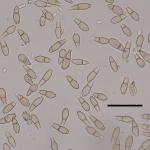Venturia Leaf and Shoot Blight of Aspen
Pathogens
While numerous species of Venturia can attack aspens and poplars (Populus), V. moreletii and V. populina are believed to be the two most destructive pathogens in North America (Sinclair and Lyon 2005). Venturia moreletii is more common on Populus species present in the northeast.
Hosts
The most common hosts of the disease in New England are bigtooth aspen (P. grandidentata) and quaking aspen (P. tremuloides) (Sinclair and Lyon 2005). Eastern cottonwood (P. deltoides) can be infected but generally shows higher disease resistance. Aspen and poplar make up less than 1% of all forest trees across Massachusetts (>1” in DBH; USDA Forest Service 2020) but are important for biodiversity. As ornamentals, they can be locally abundant but are generally not widespread.
Symptoms & Signs
In the spring, V. moreletii attacks young and developing tissues, creating dark-colored stem and foliar lesions that rapidly expand. Infected leaves and stems wilt, shrivel and become desiccated. The blackened blotches and lesions then develop an olive-green coating of asexual fungal spores. These spores are dispersed by wind and splashing rainwater to nearby shoots and leaves, resulting in new infection centers. During ideal conditions (wet and mild), the pathogen can kill all terminal shoots in affected trees. Lateral shoots may be stunted but often become resistant, preventing a complete defoliation of the canopy. Dead twig stubs and diseased, fallen leaves allow the pathogen to overwinter and initiate new infections the following spring. Younger trees in dense plantings or natural groves are more susceptible to the disease. While large groves of aspen are common in western North America, in the northeast aspen and cottonwood often occur in smaller numbers, mixed with other deciduous hardwoods or as individual trees.
Management
Remove all discarded leaves and shoots around the tree, as these harbor the pathogen and allow it to persist at the site. Prune and remove as many dead shoots and small branches as possible from the canopy, as the pathogen will readily overwinter in any diseased material that remains. Disease severity is driven by wet conditions, making this disease difficult to control during wet summers (e.g. 2021 and 2023). Disease incidence has been linked to foliar chemistry. Specifically, lower levels of the disease were found on genotypes of quaking aspen (P. tremuloides) with higher concentrations of condensed tannins (Holeski et al. 2009). Avoid planting aspen in dense groves or thinning of trees that are badly diseased to reduce disease severity. Fungicide application in the spring, as new shoots and leaves are developing, can help to protect the terminal shoots from infection and death. Fungicides are labeled for use against Venturia include: captan, mancozeb, copper-based products, myclobutanil and tebuconazole.
Citations
Holeski L.M., Vogelzang A., Stanosz G. and Lindroth R.L. 2009. Incidence of Venturia shoot blight in aspen (Populus tremuloides Michx.) varies with tree chemistry and genotype. Biochemical Systematics and Ecology 37(3): 139–145.
Sinclair WA. and Lyon HH. 2005. Diseases of Trees and Shrubs, 2nd edn. Cornell University Press, Ithaca, NY.
USDA Forest Service. 2020. Forests of Massachusetts, 2019. Resource Update FS-239. Madison, WI: U.S. Department of Agriculture Forest Service, Northern Research Station. 2 p. https://doi.org/10.2737/FS-RU-239

